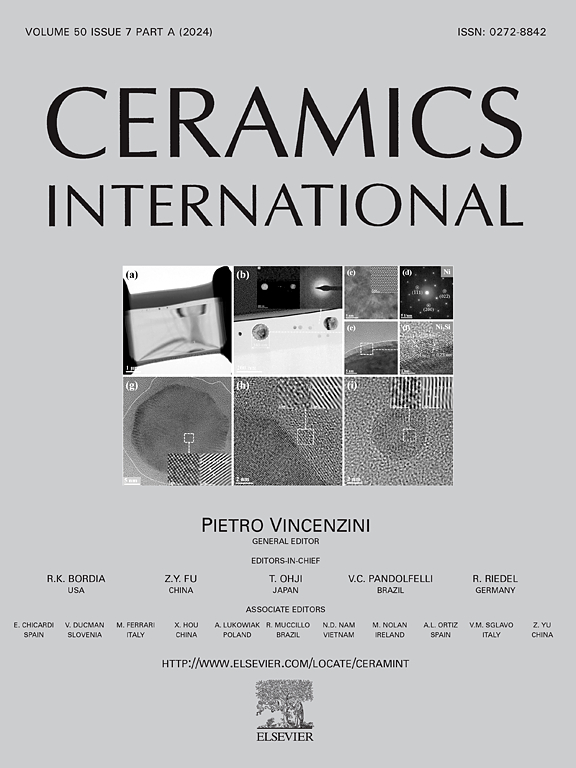采用FeCoCrNiCu高熵合金进行超快高温连接,使SiC接头具有优异的高温抗氧化性能
IF 5.1
2区 材料科学
Q1 MATERIALS SCIENCE, CERAMICS
引用次数: 0
摘要
本文采用FeCoCrNiCu高熵合金进行超快高温连接,成功地连接了SiC陶瓷。UHJ是一种新颖的连接方法,使用电加热碳毡,通过传导和辐射进行超快速样品加热。样品可在0.5 s内快速加热至1430°C。接头主要由金属硅化物、Cr(s,s)、Cu5Si和非晶碳组成。研究了制备电流和保温时间对接头组织演变和高温力学性能的影响。C颗粒含量随电流和时间的增加而增加。在40a - 45s下制备的样品表现出最好的力学性能。节理在室温和1000℃时的最大抗剪强度分别为54 MPa和33 MPa。在1000℃的高温下,系统地研究了接头的抗氧化性。在氧化过程中,C颗粒被氧化成CO2,在反应层中留下孔洞,为氧气的渗透提供了通道。钎焊焊缝中心的Cr和Si元素向高氧分压方向扩散。氧化后接头的典型组织为CrO2+(NiCoFe)Si/Si- o化合物/(NiFeCoCu)2Si/Si- o化合物/CrO2+(NiCoFe)Si。氧化接头抗剪强度为47 MPa。氧化接头强度的提高与氧化产生的压应力有关。本文章由计算机程序翻译,如有差异,请以英文原文为准。
The outstanding high-temperature oxidation resistance of SiC joint achieved via ultrafast high-temperature joining using FeCoCrNiCu high entropy alloy
In this paper, the SiC ceramic was successfully joined using FeCoCrNiCu high entropy alloy via the ultrafast high-temperature joining. UHJ is a novel joining approach using electrically heated carbon felts for ultra-fast sample heating via conduction and radiation. The sample could be rapidly heated to 1430 °C in 0.5 s. The joints are mainly composed of metal silicide, Cr(s,s), Cu5Si and amorphous carbon. The effects of preparation current and holding time on microstructure evolution and high-temperature mechanical properties of joints are investigated. C particle content increases with current and time. The samples prepared at 40 A-45 s exhibit the best mechanical properties. The maximum shear strengths of the joints at room temperature and 1000 °C were 54 MPa and 33 MPa, respectively. The oxidation resistance of the joints is systematically studied at the high temperature of 1000 °C for 10 h. C particles are oxidized to CO2 during oxidation, leaving holes in the reactive layer that provide channels for oxygen infiltration. The Cr and Si elements in the brazing seam center diffuse towards high oxygen partial pressure. After oxidation, the typical microstructure of the joint turns out to be CrO2+(NiCoFe)Si/Si-O compound/(NiFeCoCu)2Si/Si-O compound/CrO2+(NiCoFe)Si. The oxidized joint features an excellent shear strength of 47 MPa. The increase in strength of the oxidized joint is related to the compressive stress generated by the oxidation.
求助全文
通过发布文献求助,成功后即可免费获取论文全文。
去求助
来源期刊

Ceramics International
工程技术-材料科学:硅酸盐
CiteScore
9.40
自引率
15.40%
发文量
4558
审稿时长
25 days
期刊介绍:
Ceramics International covers the science of advanced ceramic materials. The journal encourages contributions that demonstrate how an understanding of the basic chemical and physical phenomena may direct materials design and stimulate ideas for new or improved processing techniques, in order to obtain materials with desired structural features and properties.
Ceramics International covers oxide and non-oxide ceramics, functional glasses, glass ceramics, amorphous inorganic non-metallic materials (and their combinations with metal and organic materials), in the form of particulates, dense or porous bodies, thin/thick films and laminated, graded and composite structures. Process related topics such as ceramic-ceramic joints or joining ceramics with dissimilar materials, as well as surface finishing and conditioning are also covered. Besides traditional processing techniques, manufacturing routes of interest include innovative procedures benefiting from externally applied stresses, electromagnetic fields and energetic beams, as well as top-down and self-assembly nanotechnology approaches. In addition, the journal welcomes submissions on bio-inspired and bio-enabled materials designs, experimentally validated multi scale modelling and simulation for materials design, and the use of the most advanced chemical and physical characterization techniques of structure, properties and behaviour.
Technologically relevant low-dimensional systems are a particular focus of Ceramics International. These include 0, 1 and 2-D nanomaterials (also covering CNTs, graphene and related materials, and diamond-like carbons), their nanocomposites, as well as nano-hybrids and hierarchical multifunctional nanostructures that might integrate molecular, biological and electronic components.
 求助内容:
求助内容: 应助结果提醒方式:
应助结果提醒方式:


